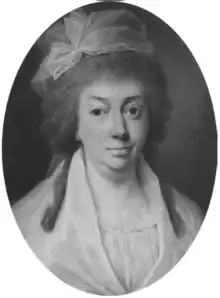Nyhavn 63
Nyhavn 63 is a historic townhouse overlooking the Nyhavn Canal in central Copenhagen, Denmark. The building is listed on the Danish Registry of Protected Buildings and Places. A warehouse in the courtyard has been converted into a hostel.
| Nyhavn 63 | |
|---|---|
_01.jpg.webp) The house seen from the other side of the canal | |
| General information | |
| Location | Copenhagen, Denmark, Europe |
| Coordinates | 55°40′46.77″N 12°35′33.17″E |
| Completed | 1756 |
History
Site history, 1689–1756
The site was originally part of a larger property. This property was listed in Copenhagen's first cadastre from 1689 as No. 20 un St. Ann's East Quarter, owned by judge Henrik Ehlers. It was later divided into a number of smaller properties.
Larsen family
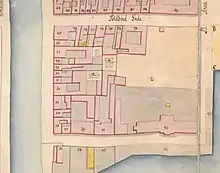
The property was acquired by timber merchant Jens Larsen in the 1750s. His property was listed in the new cadastre of 1756 as No. 32 in St. Ann's East Quarter. The present building on the site was constructed for Larsen in 1756..[1][2]
The property was after Jens Larsen's death passed to his nephew Lars Larsen. At the time of the 1787 census, he lived there with his wife Charlotte Friederiche, their 10-year-old daughter Mette Magrethe, the 53-year-old woman Mette Cathrine Bræmer, the 53-year-old widower Wibecke Cathrine Fuscher, the clerk Carl Ludwig Drewsen, a servant, a coachman, a caretaker, a housekeeper and three maids.[3] At the time of the 1787 census, No. 32 was also home to two more households.
Wilhelm Laub (1734-1800), Krigsråd and pakhusskriver at the Custom House, resided in the building with his wife Sophie Kisbye, their three children (aged 11 to 18), two maids and a caretaker.[4] The eldest of the three children, Hieronymus Laub (1771-1848), would later become a prominent clergy. The third household consisted of the beer seller (øltapper) Niels Hiorth and his wife Anna Christians Datter.[5]
At the time of the 1801 census, Lars Larsen resided in the building with his daughter Johanne M. Larsen, his son-in-law Johannes Søbøtker, their two children (aged two and three) and a large staff. All included, the household comprised 21 people.[6] The property was also home to one other household, consisting of beer seller (øltapper) Knud Pedersen, his wife Kirstine Hoskiær and one maid.[7]
In the new cadastre of 1806, the property was again listed as No. 32. It was by then still owned by Lars Larsen.
Petersen family, 1818–1900
In 1818 the building was acquired by the businessman Friderich Petersen.
Petersen's property was home to three households at the 1834 census. The owner resided on the first floor with his wife resided on the second floor with his wife C.W.Petersen, their three children (aged eight to 21), two office clerks in his firm, two male servants and one maid.[8] J. H. Sieveking, a 50-year-old unmarried merchant (grosserer) and consul-general, resided in the building with three employees (two of them married).[9] Fritz Iversen, a sailor, resided in the basement with his wife Johanne Iversen and a maid.[10]
From 1845 to 1846, the church historian P. F. A. Hammerich lived in the building while working at Trinitatis Church.[1]
In 1870, August Bournonville lived on the second floor.[1]
The property was home to 20 residents at the 1880 census. Georg Petersen (1820-1900), a wholesale merchant (''grosserer), resided on the first floor with his wife Caroline Petersen, three maids, one male servant and a coachman. The writer Wilhelm Bergsøe resided on tthe second floor with his wife Margrethe Kirstine Bergsøe, their seven-year-old son Poul Bergsøe, a maid and a female cook. Johan Thomsen, a 69-year-old man with a royal pension, resided on the ground floor with his wife Emma Mathilde Thomsen, their 35-year-old daughter Laura Augusta Mathilde Thomsen and one maid. Jacob Andersen, a concierge, resided in the basement with his wife Kirsten Andersen, their four-year-old son and the caretaker Anders Jørgensen.[11]
From 1886 to 1891,[Vilhelm Bergsøe was again resident on the second floor. His son Paul Bergsøe's memoirs Tre små vinduer (Three Small Windows) describe his childhood home in Nyhavn.[1]
In the 1880s and 1890s, royal actor Poul Reumert grew up in the building as the son of actor Elith Reumert and dancer Athalia Reumert.[1]
20th century
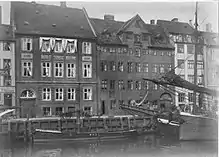
In 1910, the trading company Ørum & Wulf was based in the building. The company was founded on 13 September 1795 by N. N. Ørumin in partnership with a young merchant, Jens Andreas, but it is unclear when it moved to Nyhavn.[12] The company would close in 1912.[13]
The company Henriques & Zøylnerwqas based in the building from before 1919. In 1950, Henriques & Zøylner's Eftf. was still based in the building in 1950. The company was founded by Gustav Aron Henriques (1859-1939) and C. Zøylner (1875-1937) on 1 September 1900.[14]
The engineer Jørgen Koch resided in one of the apartments in the 1940s[1]
From 1950 to 1988, The Maritime Library (Søfartens Bibliotek) was based in the building. It had been founded by the shipping company J. Lauritzen in 1939. The company is now located in Rødovre.[15]
As of 2018, a hostel is located in the rear wing and the side wing houses a restaurant.
Architecture
The building consists of three stories over a high cellar The dormers in the roof were not added until 1942. The facade stands in undressed brick and features three stone reliefs between the first and second floor that commemorates the trade of the property's first owner. The one in the middle features a barge with timber. It is flanked by Neptune with his trifork and Mercury with his winged hat, the gods of the sea and trade.
A gateway in the left side of the building opens to a courtyard surrounded by buildings. To the right is a five bay side wing in three storeys. It was built in two storeys between 1748 and 1756 and heightened with one story before 1801. The three floor high and four bays wide rear wing was also built between 1748 and 1756. There is also a three-story, half-timbered warehouse from before 1756.[15]
The entire complex was listed on the Danish Registry of Protected Buildings and Places in 1918.[16]
Gallery
 Nyhavn 63.
Nyhavn 63.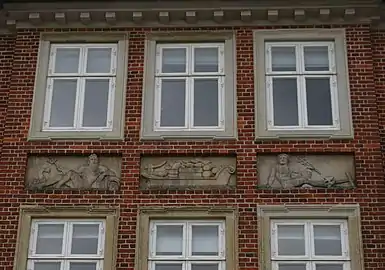 The three central reliefs on the facade, depicting a barge flanked by Neptune and Mercury.
The three central reliefs on the facade, depicting a barge flanked by Neptune and Mercury.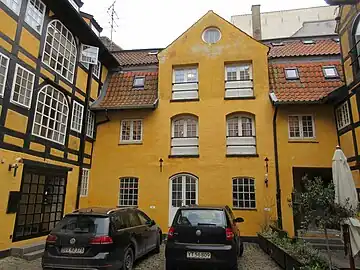 Building in the second courtyard.
Building in the second courtyard.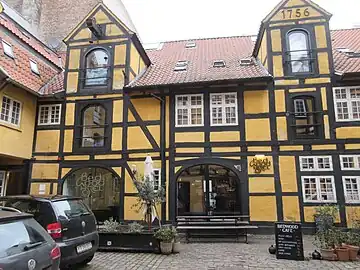 The rear wing.
The rear wing.
References
- "Nyhavn 63a-d". indenforvoldene.dk (in Danish). Retrieved 2018-01-26.
- "Nyhavns huse, knejper og nogle af beboerne". rejsefortaelling.dk (in Danish). Retrieved 2018-01-23.
- "Folketælling - 1787 - Lars Larsen". Danishfamilysearch.dk (in Danish). Retrieved 12 July 2021.
- "Folketælling - 1787 - Wilhelm Laub". Danishfamilysearch.dk (in Danish). Retrieved 12 July 2021.
- "Folketælling - 1787 - Niels Hiorth". Danishfamilysearch.dk (in Danish). Retrieved 12 July 2021.
- "Folketælling - 1801 - Lars Larsen". danishfamilysearch.dk (in Danish). Retrieved 7 December 2016.
- "Folketælling - 1801 - Knud Pedersen". danishfamilysearch.dk (in Danish). Retrieved 7 December 2016.
- "Folketælling - 1834 - F.E.Petersen". Danishfamilysearch.dk (in Danish). Retrieved 1 November 2021.
- "Folketælling - 1834 - J.H.Sieveking". Danishfamilysearch.dk (in Danish). Retrieved 1 November 2021.
- "Folketælling - 1834 - Fritz Iversen". Danishfamilysearch.dk (in Danish). Retrieved 1 November 2021.
- "Folketælling - 1880 - Nyhavn 63". Danishfamilysearch.dk (in Danish). Retrieved 8 September 2023.
- "Erhvervsdrivende, deres ansatte og andre personligheder". coneliand.dk (in Danish). Retrieved 2018-01-27.
- "Søgeresultat". dendigitalebyport.byhistorie.dk (in Danish). Retrieved 2018-01-27.
- "Erhvervsdrivende, deres ansatte og andre personligheder". coneliand.dk (in Danish). Retrieved 2018-01-27.
- "Huset". Bedwood Hostel (in Danish). Retrieved 2018-01-23.
- "Sag: NNyhavn 63". indenforvoldene.dk (in Danish). Retrieved 2018-01-23.
.png.webp)
